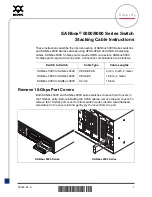
XG700 User's Guide
97/266
All Rights Reserved, Copyright (C) PFU LIMITED 2005-2006
5.6.7 bridge mac-address-table
Function
By registering static MAC addresses to the MAC address table, frames with specific destination
MAC addresses can be
forwarded to a specified port.
When a unicast static MAC address is registered, dynamic MAC addresses will not be learned, even when frames sent from
the same MAC address are received from a different port. Also, by registering multicast static MAC addresses, frames to be
sent to specific multicast can be assigned so that they will be forwarded only to the port this switch specifies. In this case, set
the multicast forwarding mode to "forward-unregistered-mac" or "filter-unregistered-mac" using the "multicast-forwarding"
command.
Use the no form to delete registered static MAC addresses.
Prompt
xg(config)#
Command syntax
bridge mac-address-table static MAC [ vlan <1-4094> ] [ port <1-12> [ <1-12> ] ]
[ agg-port <1-6> [ <1-6> ] ]
no bridge mac-address-table static MAC [ vlan <1-4094> ]
Parameter
static MAC
Specifies static MAC addresses. When a frame with this destination address is received, it will be forwarded to the port
of the specified switch.
The MAC address format is "HHHH.HHHH.HHHH," which is a 12-digit hexadecimal number with a period (.) inserted
between every four digits.
A unicast MAC address can register the information on only one port in the MAC address table. (As
for IVL, a port per VLAN) Therefore, if the same unicast MAC address is already set to a different port,
it will be replaced with the setting of a newly executed command.
A multicast MAC address can register the information on multiple ports in the MAC address table. If
the same multicast MAC address is already set to a different port, the setting of a newly executed
command will be added to it.
As for a broadcast address (FFFF.FFFF.FFFF), although it can register the information on multiple
ports, it will be replaced with the setting of the last executed command.
The following reserved multicast addresses, prescribed under the IEEE802.1D, cannot be registered.
−
In the range of 0180.C200.0000 - 0180.C200.0010
−
In the range of 0180.C200.0020 - 0180.C200.002F
vlan <1-4094>
Specifies VLAN to register the MAC address. Specifies VLAN in the range of 1 to 4094.
This parameter is valid only when the learning mode of the MAC address table is IVL (Independent Vlan Learning). For
SVL (Shared Vlan Learning), this parameter is not necessary.
port <1-12> [ <1-12> ]
Specifies the port number to which a frame is forwarded. This parameter is specified in the range of 1 to the maximum
port number (=12).
Additionally, only when MAC addresses to register are static multicast addresses (including broadcast addresses),
multiple addresses can be specified by separating the port numbers with " " (space).
agg-port <1-6> [ <1-6> ]
Specifies the aggregation group number to which a frame is forwarded. This parameter is specified in the range of 1 to
6.
Additionally, only when MAC addresses to register are static multicast addresses (including broadcast addresses),
multiple addresses can be specified by separating the aggregation group numbers with " " (space).
Command type
Configuration command
Default
Only broadcast address (FFFF.FFFF.FFFF) is registered.
Message
% Unable to translate mac address %1$
Explanation
The specified format of the MAC address is incorrect.
[[Inserted string]]%1$: specified MAC address
Solution
After reviewing the specified format of the MAC address, execute the command again.
% Can't set vlan in case of shared-vlan-learning.
Explanation
When bridge learn-mode is SVL, VLAN cannot be specified.
Solution
Omit the specification of vlan, and execute the command again.
















































